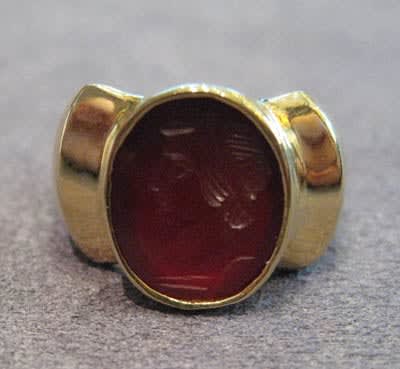Carnelian Intaglio of a Bust of a Roman Emperor, 1700 CE - 1800 CE
Carnelian, Gold
FJ.6489
The art of glyptics, or carving on colored precious stones, is probably one of the oldest known to humanity. Intaglios, gems with an incised design, were made as early as...
The art of glyptics, or carving on colored precious stones, is probably one of the oldest known to humanity. Intaglios, gems with an incised design, were made as early as the fourth and third millennia BC in Mesopotamia and Aegean Islands. They display a virtuosity of execution that suggests an old and stable tradition rooted in the earliest centuries. The tools required for carving gems were simple: a wheel with a belt-drive and a set of drills. Abrasives were necessary since the minerals used were too hard for a metal edge. A special difficulty of engraving intaglios, aside from their miniature size, was that the master had to work with a mirror image in mind.
Ancient coins were often the source material for eighteenth century engravers eager to render accurate images of Roman emperors and their gods. These artists utilized large numismatic collections of the wealthy and the nobility, who were often the clients for intaglio rings. The portrait on this intaglio resembles the youthful emperor Constans (A.D.337 - 350), the youngest son of emperor Constantine the Great and Fausta. Engraved with great delicacy the features reveal a handsome man with a gentle expression, his hair and cap clearly delineated. Engravers of the classical revival period attempted to excel the artists of the ancient world; and in seeing this intaglio, we have ample proof of one engraver's success.
Ancient coins were often the source material for eighteenth century engravers eager to render accurate images of Roman emperors and their gods. These artists utilized large numismatic collections of the wealthy and the nobility, who were often the clients for intaglio rings. The portrait on this intaglio resembles the youthful emperor Constans (A.D.337 - 350), the youngest son of emperor Constantine the Great and Fausta. Engraved with great delicacy the features reveal a handsome man with a gentle expression, his hair and cap clearly delineated. Engravers of the classical revival period attempted to excel the artists of the ancient world; and in seeing this intaglio, we have ample proof of one engraver's success.
